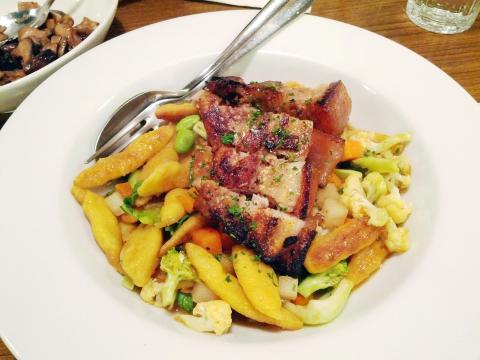Entering the Meowvelous Cafe and Restaurant (貓下去西餐快炒小館) feels like stumbling upon a well-kept secret. This intimate, cozy bistro serves French-style home cooking in an unlikely neighborhood, a quiet set of streets behind National Taiwan University Hospital, where little traffic passes through and lines of tall camphor trees stand, their leaves rustling gently on breezy days.
With its bright yellow neon sign, Meowvelous is one of the area’s few signs of life in the evenings, and on weekends it’s not uncommon to see a line of people outside waiting for a table, even in chilly winter weather. We showed up without reservations last Saturday and waited around 15 minutes, standing in a light, drizzling rain, and it was worth it. From start to finish, our meal was marvelous.
I had already been won over with the first sip of the restaurant’s soup of the day. The taste of this orange-red pureed concoction, which looked like a ho-hum cup of tomato soup, stopped us in our tracks. It was hearty with a complex mix of sweet and piquant flavors and a smoky aftertaste. The waiter almost seemed like he was waiting for us to ask him about the soup. He immediately smiled and rattled off the ingredients: apple, tomato paste, corn and a dash of Tabasco sauce.

Photo: David Chen , Taipei Times
We pondered this unusual but delightful alchemy while gazing at the half-dozen or so cooks working busily in the open kitchen. The restaurant, located in a long and narrow first-floor apartment, is divided into two halves, with diners lining one side and the kitchen and wait staff, all donning white shirts, on the other. The kitchen takes up half of the space, but the place feels cozy rather than claustrophobic. Meowvelous also sports a vague hipster vibe with indie rock and electronica piped through the house speakers, albeit at a reasonable volume.
The menu is fairly simple, with a selection of appetizers that average NT$250 per plate and include dishes such as pan-fried calamari with anchovy mayonnaise and shrimp and green pea with scrambled egg on crostini (small slices of grilled bread).
For main courses, there’s a handful of pasta and risotto dishes, which run between NT$260 to NT$380. For bigger appetites, there are several meat main courses for NT$580, which include an 8oz grilled steak and fries, the restaurant’s nod to the classic French dish steak frites, and “pan roast free range chicken” with sauteed vegetables.
On our visit, I went for one of the daily specials, roast belly pork (烤豬五花) with curried potato dumplings and sauteed vegetables (NT$560), which was pure comfort on a plate. The pork was sumptuous while the perfectly chopped bits of broccoli, carrot, cauliflower and edamame beans had a buttery flavor. The potato dumplings had a sweet zing from the curry and a nice, chewy texture to offset the melt-in-your-mouth softness of the roast pork.
My dining companion ordered the carrot and apple risotto with mixed vegetables, bacon and hash brown (NT$300). From the few bites I had, I felt it was a tad bit too sweet, but the dish was prepared well. The risotto was cooked to a proper, creamy consistency, and although unusual, the crispy hash brown was a nice accompaniment.
Meowvelous does well with simple dishes such as the sauteed mushrooms (NT$120), a mix of fresh shitake and white button mushrooms cooked with fresh herbs and white wine. One item I’m looking forward to trying is the club sandwich with fries (NT$260). It looked scrumptious in photos posted on Meowvelous’ Facebook page, which happens to be a good place to get a glimpse of the beautiful presentation of its meals.
Meowvelous, which is only open in the evenings, also makes for a nice place to have a drink, with an extensive selection of cocktails (NT$150 to NT$180), imported bottled beers from Belgium and Germany (NT$180) and wines at NT$200 a glass or NT$900 a bottle.
Our meal ended as brilliantly as it began, with a tangy and creamy lemon tart pudding (NT$100) that already had me anticipating my next visit.
The restaurant seats around 25 persons. Reservations are recommended and limited to parties of up to four persons.

April 14 to April 20 In March 1947, Sising Katadrepan urged the government to drop the “high mountain people” (高山族) designation for Indigenous Taiwanese and refer to them as “Taiwan people” (台灣族). He considered the term derogatory, arguing that it made them sound like animals. The Taiwan Provincial Government agreed to stop using the term, stating that Indigenous Taiwanese suffered all sorts of discrimination and oppression under the Japanese and were forced to live in the mountains as outsiders to society. Now, under the new regime, they would be seen as equals, thus they should be henceforth

Last week, the the National Immigration Agency (NIA) told the legislature that more than 10,000 naturalized Taiwanese citizens from the People’s Republic of China (PRC) risked having their citizenship revoked if they failed to provide proof that they had renounced their Chinese household registration within the next three months. Renunciation is required under the Act Governing Relations Between the People of the Taiwan Area and the Mainland Area (臺灣地區與大陸地區人民關係條例), as amended in 2004, though it was only a legal requirement after 2000. Prior to that, it had been only an administrative requirement since the Nationality Act (國籍法) was established in

Three big changes have transformed the landscape of Taiwan’s local patronage factions: Increasing Democratic Progressive Party (DPP) involvement, rising new factions and the Chinese Nationalist Party’s (KMT) significantly weakened control. GREEN FACTIONS It is said that “south of the Zhuoshui River (濁水溪), there is no blue-green divide,” meaning that from Yunlin County south there is no difference between KMT and DPP politicians. This is not always true, but there is more than a grain of truth to it. Traditionally, DPP factions are viewed as national entities, with their primary function to secure plum positions in the party and government. This is not unusual

The other day, a friend decided to playfully name our individual roles within the group: planner, emotional support, and so on. I was the fault-finder — or, as she put it, “the grumpy teenager” — who points out problems, but doesn’t suggest alternatives. She was only kidding around, but she struck at an insecurity I have: that I’m unacceptably, intolerably negative. My first instinct is to stress-test ideas for potential flaws. This critical tendency serves me well professionally, and feels true to who I am. If I don’t enjoy a film, for example, I don’t swallow my opinion. But I sometimes worry